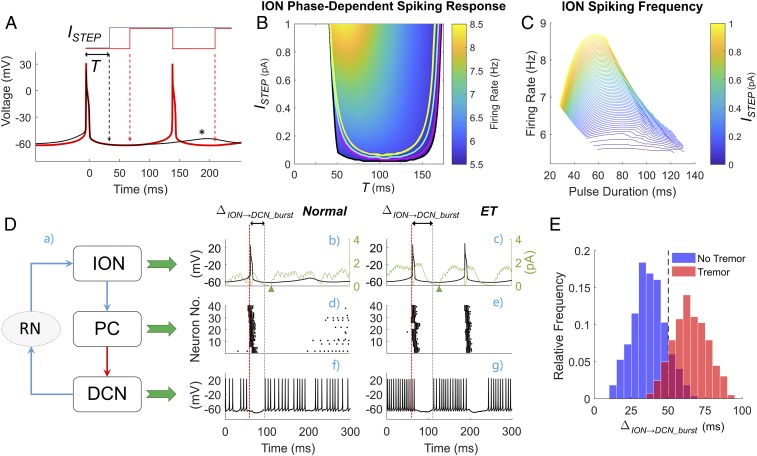Fig. 4.
Role of the phase of ION subthreshold oscillations in the generation of tremor-related network oscillations. (A) In any ION neuron, the lag between an action potential and the peak of the following subthrehsold oscillation (black asterisk) defines the duration of the oscillation cycle. The onset time T of the depolarizing input current ISTEP is varied between 0 (i.e., at the time of the action potential) and the peak of the subthreshold oscillation. The current is transiently turned off when an action potential is generated (red line). (B) Two-dimensional map depicting the region of the parameter space (ISTEP, T) where ION neurons sustain tonic spiking along with the resultant firing rate. Curves in black, pink, cyan, green, and yellow denote the region where at least 4, 5, 6, 7, or all ION neurons sustain spiking simultaneously, respectively. For each combination (ISTEP, T) in B, three model instances were simulated over a 4,000-ms-long period, and the simulation results from the first 1,000 ms were discarded. The firing rate was measured from any ION neuron that sustained spiking until the end of simulation. (C) The ION firing rate as a function of the duration of the current ISTEP for several values of the current intensity. (D) Role of the dentato-rubro-olivary pathway in propagating tremor-related oscillations through the olivocerebellar loop. A schematic of the interconnections between ION, PC, and DCN cells mediated by disynaptic connections through the red nucleus (RN) is provided (a) along with the simulated spiking activity of an ION neuron (black lines; b and c), PCs (d and e), and the DCN (f and g) under normal, tremor-free condition (b, d, and f) and ET condition (i.e., yellow circle in Fig. 3A) (c, e, and g). Green lines in b and c denote the postsynaptic glutammatergic currents to the ION neuron mediated by the RN. The red vertical lines denote the onset time for the ION neuron’s action potential. This action potential elicits a complex spike in the PCs, which hyperpolarizes the DCN and causes a posthyperpolarization rebound burst (f and g). The lag ΔION→DCN_burst between the ION neuron’s action potential and the DCN rebound predicts whether the ION neuron will spike again and corresponds to the parameter T in A and B. Time scales in f and g also apply to b and d and to c and e, respectively. (E) Histogram of the values of ΔION→DCN_burst measured under nontremor (blue bars) and ET conditions (red bars). For each condition, data were obtained from the simulations reported in Fig. 3A.

